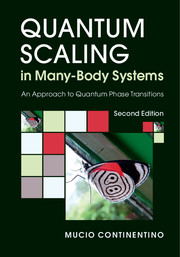Book contents
- Frontmatter
- Dedication
- Contents
- Preface
- 1 Scaling Theory of Quantum Critical Phenomena
- 2 Landau and Gaussian Theories
- 3 Real Space Renormalisation Group Approach
- 4 Renormalisation Group: the ∊-Expansion
- 5 Quantum Phase Transitions
- 6 Heavy Fermions
- 7 A Microscopic Model for Heavy Fermions
- 8 Metal and Superfluid–Insulator Transitions
- 9 Density-Driven Metal–Insulator Transitions
- 10 Mott Transitions
- 11 The Non-Linear Sigma Model
- 12 Superconductor Quantum Critical Points
- 13 Topological Quantum Phase Transitions
- 14 Fluctuation-Induced Quantum Phase Transitions
- 15 Scaling Theory of First-Order Quantum Phase Transitions
- Appendix
- References
- Index
8 - Metal and Superfluid–Insulator Transitions
Published online by Cambridge University Press: 04 May 2017
- Frontmatter
- Dedication
- Contents
- Preface
- 1 Scaling Theory of Quantum Critical Phenomena
- 2 Landau and Gaussian Theories
- 3 Real Space Renormalisation Group Approach
- 4 Renormalisation Group: the ∊-Expansion
- 5 Quantum Phase Transitions
- 6 Heavy Fermions
- 7 A Microscopic Model for Heavy Fermions
- 8 Metal and Superfluid–Insulator Transitions
- 9 Density-Driven Metal–Insulator Transitions
- 10 Mott Transitions
- 11 The Non-Linear Sigma Model
- 12 Superconductor Quantum Critical Points
- 13 Topological Quantum Phase Transitions
- 14 Fluctuation-Induced Quantum Phase Transitions
- 15 Scaling Theory of First-Order Quantum Phase Transitions
- Appendix
- References
- Index
Summary
Conductivity and Charge Stiffness
In this chapter, we will consider initially metal–insulator (MI) transitions which occur in pure systems without disorder. In the final section we consider a superfluid–insulator transition induced by some special type of disorder. We will show that the quantities which characterise the phase transitions in both problems obey similar scaling laws and are governed by similar exponents.
Differently from the magnetic transitions treated before metal–insulator (MI) transitions have no obvious order parameter to distinguish the metallic from the insulating phase. This precludes a power expansion of the free energy in terms of a small quantity as for magnetic phase transitions. In spite of that, the concepts of phase transitions and critical phenomena turn out to be very useful to describe metal–insulator transitions. In case this problem is approached using the renormalisation group, the localisation transition is associated with an unstable fixed point and the flow of the RG equations to the different attractors is sufficient to distinguish the nature of the phases. Then, in general, we can associate a set of critical exponents with the MI transitions. Besides, these exponents are not independent but obey scaling relations. Since we are concerned with zero temperature instabilities, the quantum hyperscaling law, Eq. 1.18, plays a crucial role in this problem.
We will distinguish here two different types of metal–insulator transitions. Those due to a competition between parameters of the relevant Hamiltonian and metal–insulator transitions arising by varying the number of electrons or chemical potential. An example of the former is the Mott transition due to the competition between kinetic energy and the local Coulomb repulsion as described by the half-filled band Hubbard model. The latter will be referred as density-driven metal– insulator transitions in analogy with the superfluid–insulator transition in bosonic systems with varying particle number (Fisher et al., 1989). These two types of transitions may occur in the same system or Hamiltonian. They in general belong to different universality classes and consequently have different critical exponents.
- Type
- Chapter
- Information
- Quantum Scaling in Many-Body SystemsAn Approach to Quantum Phase Transitions, pp. 102 - 114Publisher: Cambridge University PressPrint publication year: 2017



